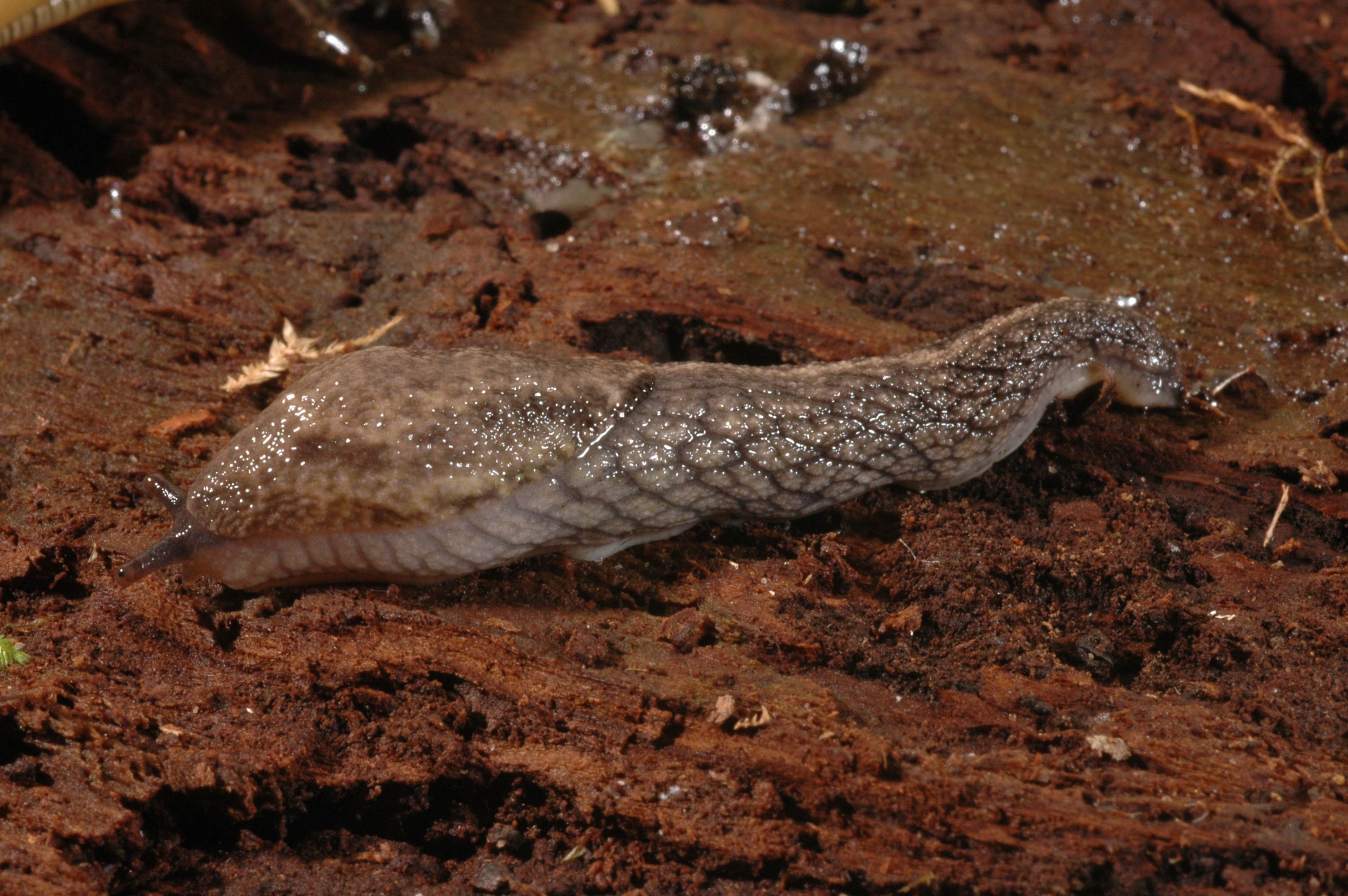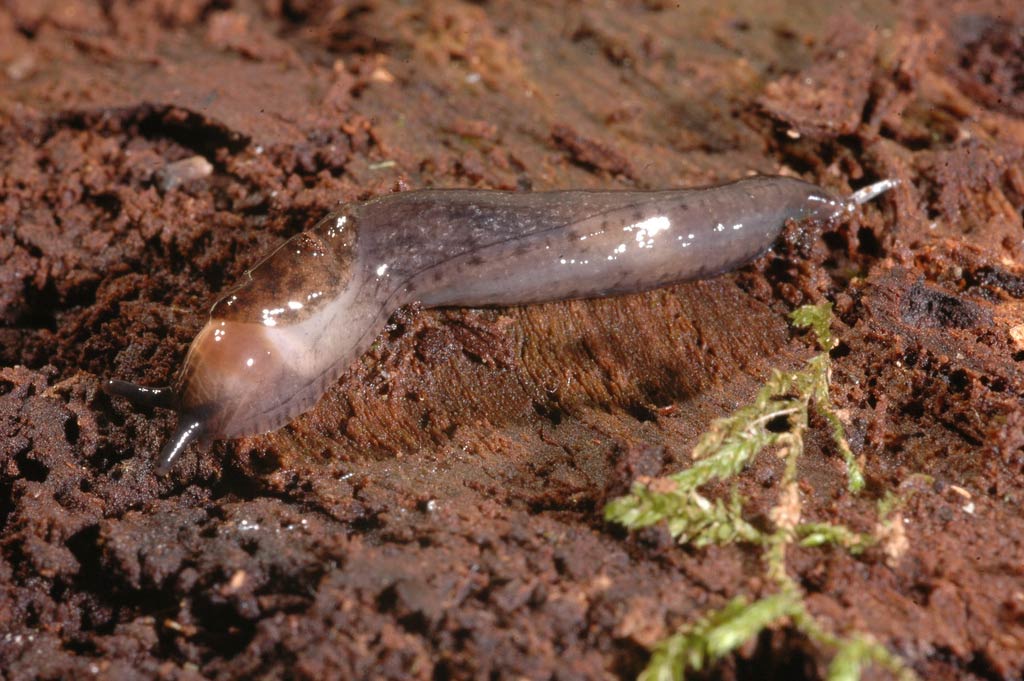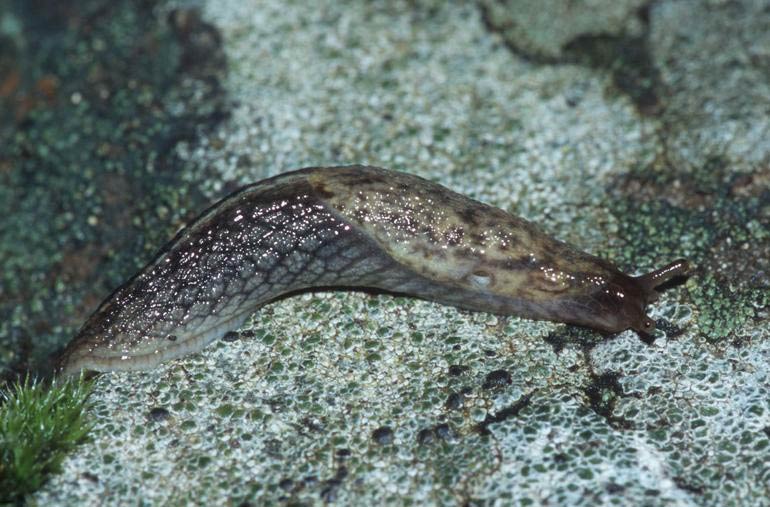Prophysaon andersonii
|
Prophysaon andersonii. (Photo: © J. Slapcinsky, Florida Museum of Natural History) |
|
Prophysaon andersonii. (Photo: © J. Slapcinsky, Florida Museum of Natural History) |
|
Prophysaon andersonii. (Photo: © B. Frank, Jacksonville) |
|
Prophysaon andersonii. (Photo: © 2004 William Leonard) |
|
Prophysaon andersonii: genitalia. (Photo: © J. White, U.F.) |
Family
Anadenidae
Species
Prophysaon andersonii (Cooper, 1872)
Common name
Reticulate Reticulate:
A network pattern of lines or grooves.
taildropper
Description
A mature, adult slugSlug:
A snail that either does not possess a shell or has one that is very reduced (no definite coiling) or internal.
can attain a length of approximately 64 mm. The pale brown, red-grey or yellow body of the slugSlug:
A snail that either does not possess a shell or has one that is very reduced (no definite coiling) or internal.
is usually clouded with darker shades. The tentaclesTentacles:
Sensory projections on the head end of a mollusc. There are generally two pairs; upper (posterior) and smaller, lower (anterior). The upper pair bears the eyes. In many snails the eyes are located at the tips of this structure; however, in Basommatophoran snail species, the eyes are located at the base of the tentacles.
are usually dark brown. This slugSlug:
A snail that either does not possess a shell or has one that is very reduced (no definite coiling) or internal.
has a characteristic diamond-mesh pattern on the dorsal surface of its body, due to the arrangement of the tuberclesTubercles:
An enlarged or raised region on the body of a slug. The shape of this structure is very variable. (See also tubercle)
. The pale, finely granulated mantleMantle:
A fleshy, membranous covering of the anterior portion of the body of a mollusc. It secretes the materials that form the shell.
often has two, dark lateral lines running its length. The pneumostomePneumostome:
This is the breathing hole on the right side of the mantle of molluscs. This allows air to pass through to the lung for gas exchange.(See also breathing pore).
(breathing pore) is anteriorly or medially located on the mantleMantle:
A fleshy, membranous covering of the anterior portion of the body of a mollusc. It secretes the materials that form the shell.
. The fringe of the footFoot:
The muscular organ on the undersurface of the body of a mollusc upon which the animal rests or uses to crawl.
is pale and does not possess any dark bands; however, faint lines may be observed. The sole is brilliant white to dirty white with a highly contrasting mucus color (lemon yellow to orange). The tail is acute in shape. When contracted, the body of the slugSlug:
A snail that either does not possess a shell or has one that is very reduced (no definite coiling) or internal.
is tadpole-shaped.
The genus Prophysaon has nine recognized species. According to Pilsbry's (1948), there are two species groups (subgenera) in this genus:
1. Prophysaon: In this group, the epiphallus is extremely long and slender except it enlarges abruptly near the insertion in the penis.
- P. boreale (Northern taildropper): Body finely reticulateReticulate:
A network pattern of lines or grooves.
, with pale dorsal line. Penis not much shorter than muscular body of the epiphallus. - P. foliolatum (Yellow-bordered taildropper): Body finely reticulateReticulate:
A network pattern of lines or grooves.
, with pale dorsal line. Penis much shorter than muscular body of the epiphallus. Large species (~ 90 mm). - P. andersonii (Reticulate taildropper): Body finely reticulateReticulate:
A network pattern of lines or grooves.
, with pale dorsal line. Penis much shorter than muscular body of the epiphallus. Small species (~ 64 mm). - P. coeruleum (Blue-gray taildropper): Body not finely reticulateReticulate:
A network pattern of lines or grooves.
, no pale dorsal line. Muscular body of the epiphallus very short. Uniform blue-gray slugSlug:
A snail that either does not possess a shell or has one that is very reduced (no definite coiling) or internal.
. - P. dubium (Papillose taildropper): Body not finely reticulateReticulate:
A network pattern of lines or grooves.
, no pale dorsal line. Muscular body of the epiphallus long. Purple-gray slugSlug:
A snail that either does not possess a shell or has one that is very reduced (no definite coiling) or internal.
.
2. Mimetarion: In this group, the epiphallus is of moderate length and slender. Initially, the epiphallus is much wider than the vas deferns, but tapers where both structures meet.
- P. fasciatum (Banded taildropper): Vagina and spermathecal duct slender and very long. Penis sac broad.
- P. obscurum (Mottled taildropper): Vagina and spermathecal duct slender and very long. Penis sac narrow.
- P. vanattae (Scarlet-backed taildropper): Vagina and spermathecal duct stout and very short. Cavity of epiphallus possess two longitudinal ridges.
- P. humile (Smoky taildropper): Vagina and spermathecal duct stout and very short. Cavity of epiphallus possess one longitudinal ridge.
Native range
North America
Distribution
North America:
- U.S.: Alaska to California and east to Idaho
- Canada: British Columbia
Ecology
This slugSlug:
A snail that either does not possess a shell or has one that is very reduced (no definite coiling) or internal.
will occur in wooded areas, gardens and disturbed habitats. It has the ability to self-amputate and regenerate its tail. The site of potential amputation characteristically has a diagonal constriction and a may appear as a dark line on the sole of the footFoot:
The muscular organ on the undersurface of the body of a mollusc upon which the animal rests or uses to crawl.
.
Synonyms
- Arion andersonii
References
Forsyth 2004Forsyth 2004:
Forsyth, R.G. 2004. Royal BC museum handbook: land snails of British Columbia. Victoria, Canada: Royal BC Museum. pp. 1-188.; Ovaska et al. 2004Ovaska et al. 2004:
Ovaska, K., W.P. Leonard, L. Chichester, T.E. Burke, L. Sopuck and J. Baugh. 2004. Prophysoan coeruleum Cockerell, 1890, blue-gray taildropper (Gastropoda: Arionidae): New Distributional records and reproductive anatomy. Western North American Naturalist 64: 538-543.; Pilsbry 1948Pilsbry 1948:
Pilsbry, H. A. 1948. Land Mollusca of North America north of Mexico vol. II part 2. Academy of Natural Sciences, Philadelphia. pp. 521-1113.






